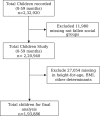Decomposing social groups differential in stunting among children under five in India using nationally representative sample data
- PMID: 39516279
- PMCID: PMC11549304
- DOI: 10.1038/s41598-024-78796-3
Decomposing social groups differential in stunting among children under five in India using nationally representative sample data
Abstract
Stunting among children is a reflection of the chronic malnutrition caused by a complex set of behavioural, demographic, and socioeconomic factors. This long-term detrimental exposure to chronic malnutrition is disproportionately higher among social and economically deprived groups, leading to significant differentials in the prevalence of stunting across various social strata. Therefore, this study investigates the inequality of social groups in terms of the prevalence of stunting across Schedule Caste (SC)-Scheduled Tribe (ST) and non-SC-ST. The study used 1,93,886 children's data aged 0-59 months from the recent round of the National Family Health Survey. Descriptive statistics, multivariable logistic regression, F-test, t-test and chi-squared (χ²) test were applied to understand the prevalence, determinants, and associations, respectively. The Fairlie decomposition model was applied to quantify the factors contributing to the inequality of stunting across social groups. The results revealed that the prevalence of stunting was higher among SC-ST (39.60%) children compared to non-SC-ST (33.27%). In addition, children aged 15-30 months (AOR: 1.895, 95% CI: 1.843-1.949), and male (AOR: 1.074, 95% CI: 1.053-1.095), mothers had lower BMI (AOR: 1.543, 95% CI: 1.492-1.595), mothers who had no education (AOR: 1.595, 95% CI: 11.532-1.662), belongs to poorest wealth index (AOR: 1.857, 95% CI: 1.766-1.952), and the children belong to the household with unhygienic satiation practices (AOR: 1.097, 95% CI: 1.070-1.123) were more likely to be stunted. The decomposition results revealed that the variables included in the study could explain 68.9% of the stunting inequality between SC-ST and non-SC-ST groups. The household's wealth index is found to be a leading factor, which contributed nearly 41.3% of total stunting inequality exists between these two groups, followed by mothers' education (12.86%) and mothers' BMI (11.02%), sanitation facilities (4.26%), children's birth order (3.32%) and mother's type of delivery (1.49%). These findings emphasize the importance of targeted interventions. Prioritizing policies that address household economic enhancement, women's education and empowerment can be instrumental in reducing social group inequality and lowering the overall prevalence of stunting. Ensuring access to improved hygienic sanitation facilities in the household is equally important for achieving better health outcomes for the children.
Keywords: And India; Fairlie decomposition; Inequality; Malnutrition; Stunting.
© 2024. The Author(s).
Conflict of interest statement
The authors declare no competing interests.
Figures
Similar articles
-
Poverty induced inequality in nutrition among children born during 2010-2021 in India.PLoS One. 2024 Nov 14;19(11):e0313596. doi: 10.1371/journal.pone.0313596. eCollection 2024. PLoS One. 2024. PMID: 39541291 Free PMC article.
-
Effect of wealth, social inequality, Mother's BMI, and education level on child malnutrition in India.Diabetes Metab Syndr. 2021 Nov-Dec;15(6):102304. doi: 10.1016/j.dsx.2021.102304. Epub 2021 Sep 29. Diabetes Metab Syndr. 2021. PMID: 34601344
-
Socioeconomic disparities in child malnutrition: trends, determinants, and policy implications from the Kenya demographic and health survey (2014 - 2022).BMC Public Health. 2025 Jan 24;25(1):295. doi: 10.1186/s12889-024-21037-z. BMC Public Health. 2025. PMID: 39849437 Free PMC article.
-
Trends of wealth-related inequality in stunting and its contributing factors among under-five children in Ethiopia: Decomposing the concentration index using Ethiopian Demographic Health Surveys 2011-2019.PLoS One. 2025 Feb 12;20(2):e0314646. doi: 10.1371/journal.pone.0314646. eCollection 2025. PLoS One. 2025. PMID: 39937754 Free PMC article.
-
Prevalence of malnutrition among children and women of reproductive age in Uruguay by socio-economic status and educational level.Public Health Nutr. 2020 Aug;23(S1):s101-s107. doi: 10.1017/S1368980020000804. Epub 2020 Apr 17. Public Health Nutr. 2020. PMID: 32299530 Free PMC article. Review.
References
-
- World Health Organization. Childhood Stunting: Challenges and Opportunities. (2013).
MeSH terms
LinkOut - more resources
Full Text Sources
Medical


